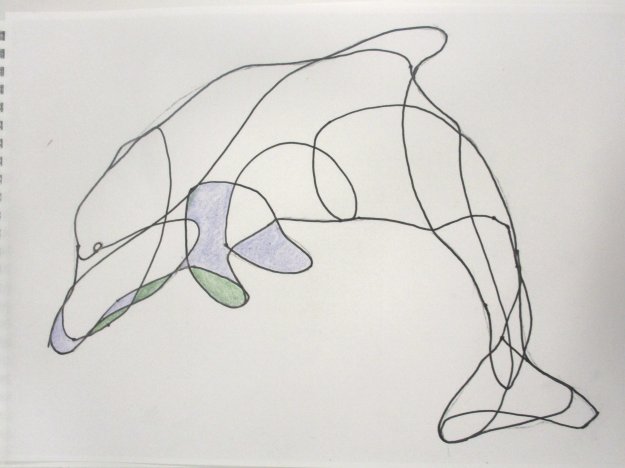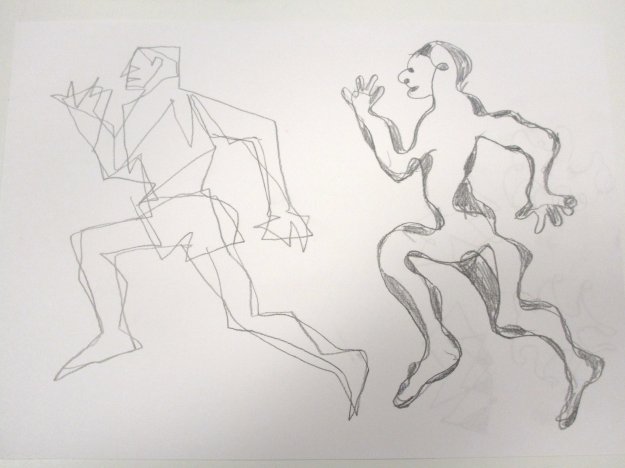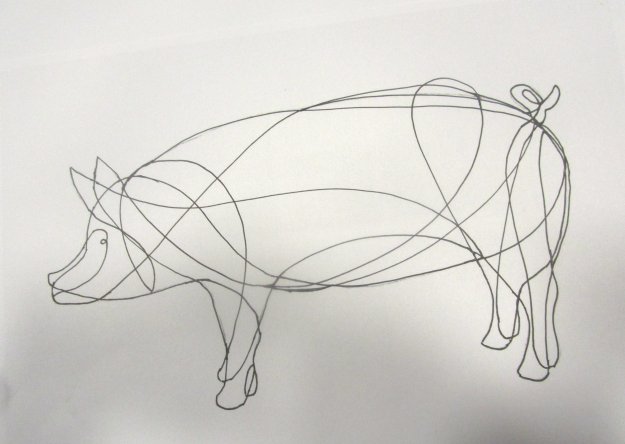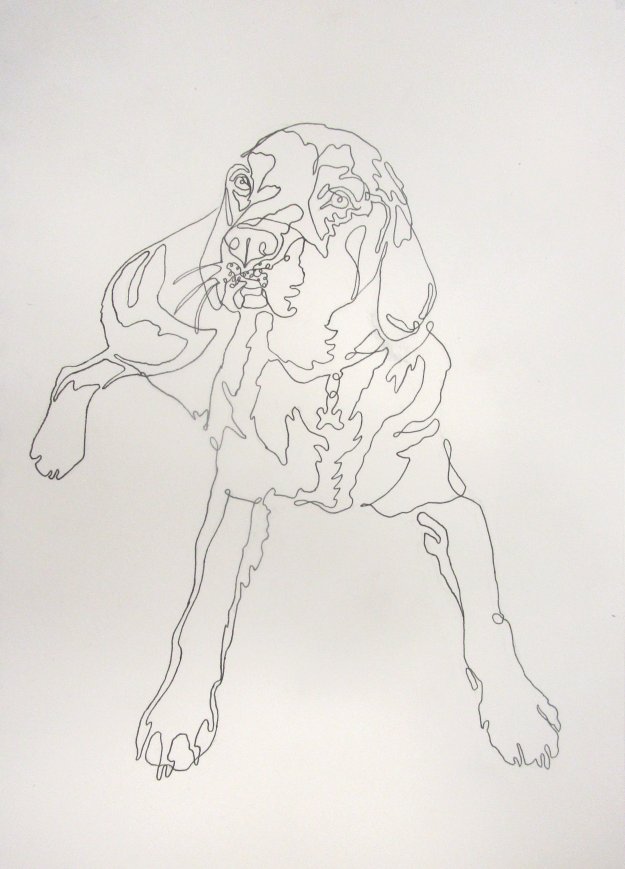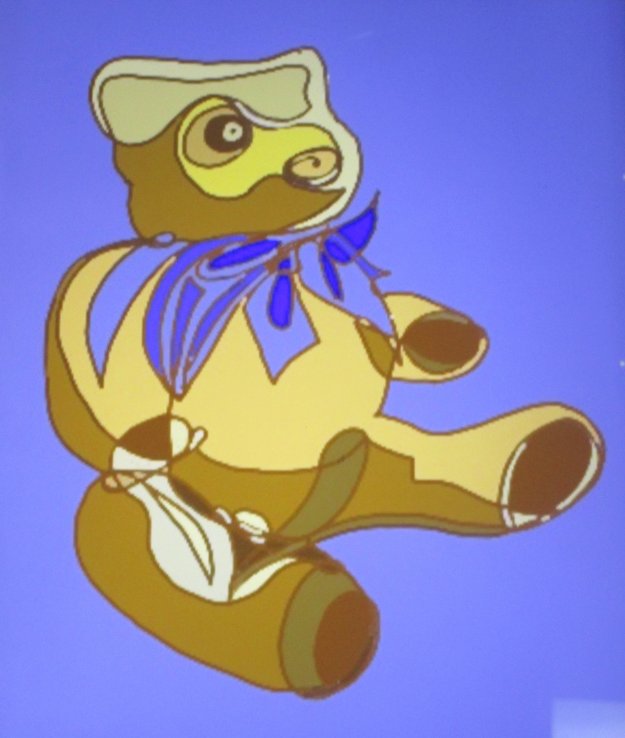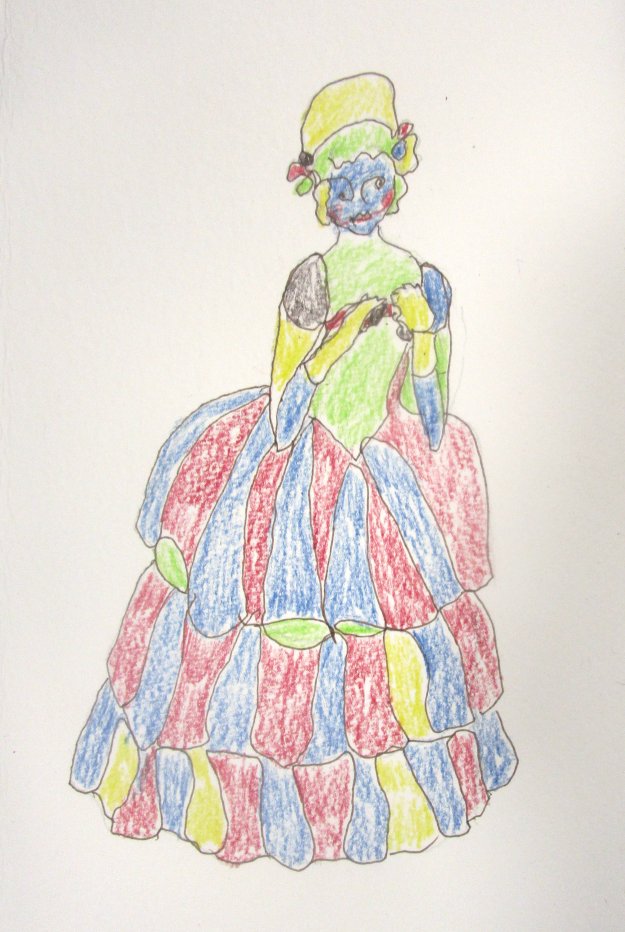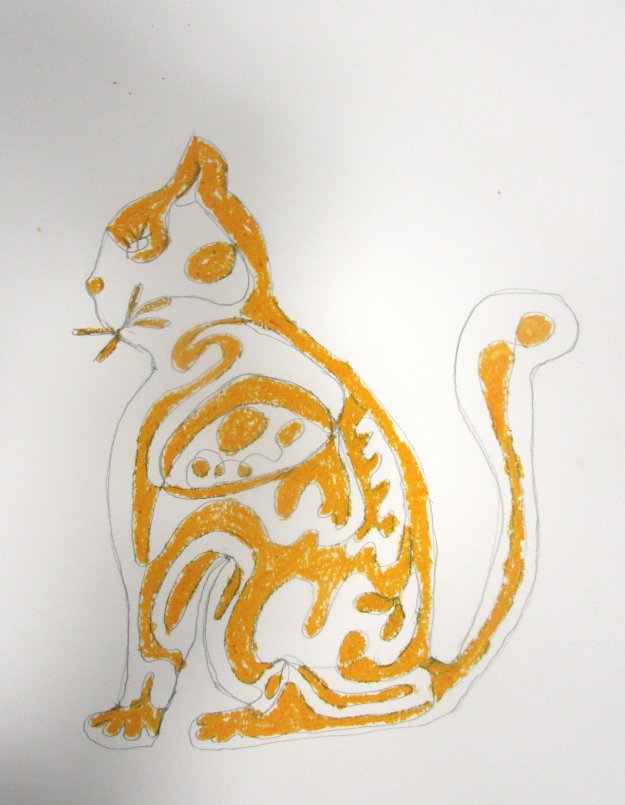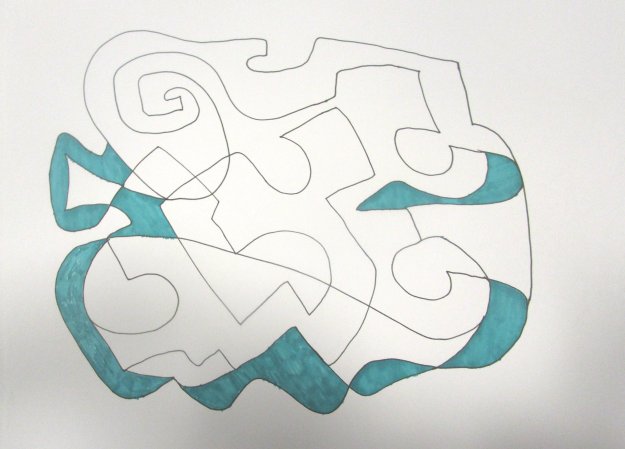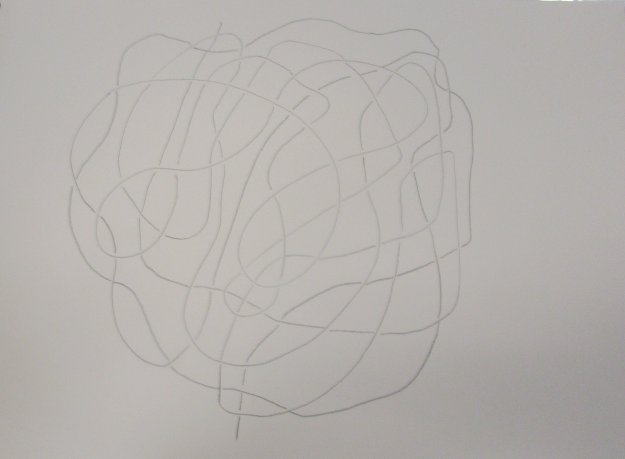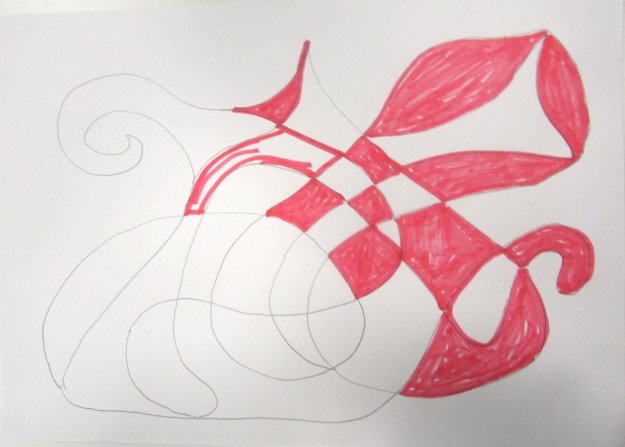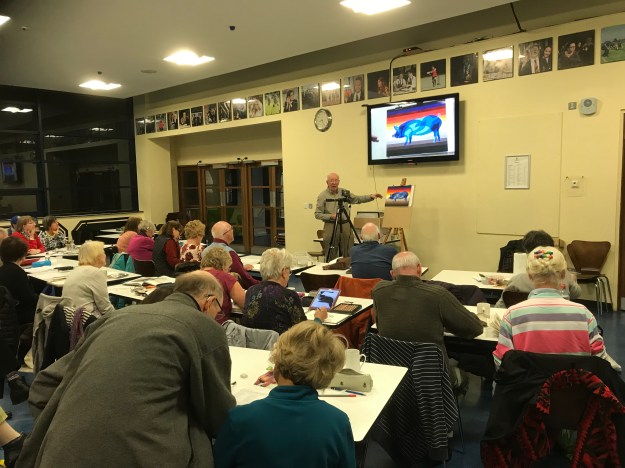
Clyde the Elephant, single continuous line with colour sequence by Mick Burton.
This is the continuation post covering my demonstration and workshop at Harrogate and Nidderdale Art Club on 6 December 2018.
Here is a reminder of my marker pen attempt at a continuous line elephant.
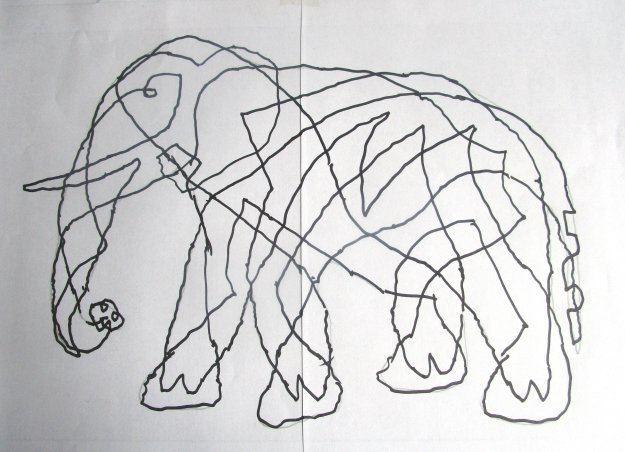
Demonstration of a Single Continuous Line Elephant, initial drawing, at Harrogate and Nidderdale Art Club by Mick Burton, on 6 December 2018.
At home later I followed the line/s around and found that there was more than one line and I needed to do one or two diversions to correct that. As the pattern at the front of the neck has a sort of square which I needed to get rid of I used that region to also turn the drawing into a single line throughout. With a bit of general smoothing of arcs all round I arrived at the following revised elephant.
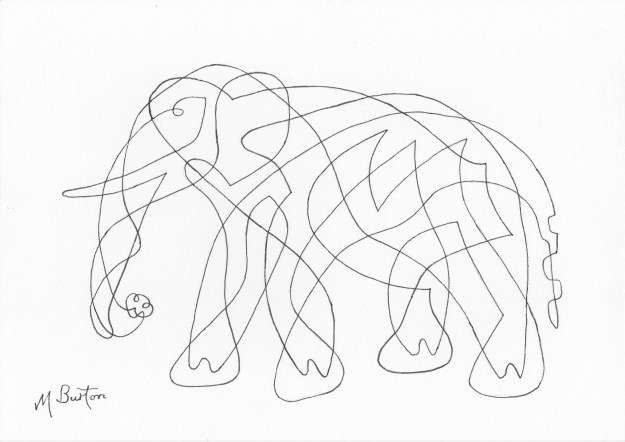
Revised single continuous line elephant. Mick Burton, Leeds Artist.
The next stage was to apply my Colour Sequence to the lines, which I completed in the last few days. The result is shown at the top of this post.
To explain the process I use, and how it works, I will briefly go through the illustrations which I used later on in the Demonstration at Harrogate and Nidderdale Art Club.
We start by drawing a winding line in an anticlockwise direction.

Stage 1. Single line drawn anticlockwise. Mick Burton explains colour sequence.
Then, starting on an outside section of line, overdraw in red alternate sections of line. This results in three different continuous line sections bounded by a red line.

Stage 2. Overdraw in red missing alternate sections. Mick Burton explains colour sequence.
We can now number all the areas to indicate where the colours in the sequence go. Call the outside 0 and number through the sections to 5 in the middle. You will see that each channel between red lines has alternately numbered areas.

Stage 3. Number the areas in sequence from the outside (being 0) to the middle (being 5). Mick Burton explains colour sequence.
I have already decided on a sequence of colours to use, running from light tones to darker and from yellow to red. First apply yellow and gold alternately throughout the outer corridor.

Stage 4. Paint alternate colours within the outer corridor. Mick Burton explains Colour Sequence.
Paint in the next two colours from the sequence – orange (which looks reddish here) and red – alternately in the inner corridor. You can see how the colours are lining up in natural sequence of tone and colour.
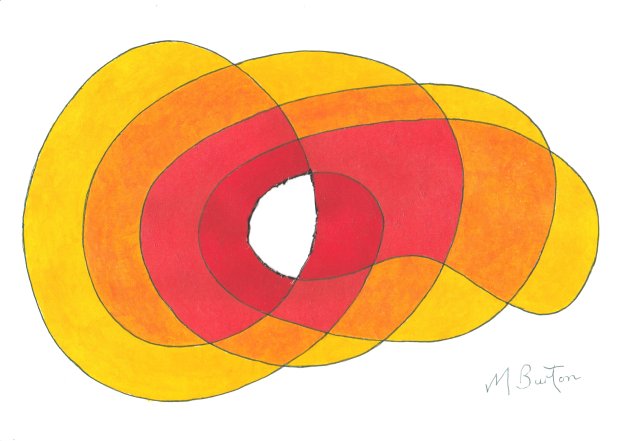
Stage 5. Paint second set of alternate colours (orange, which looks reddish here, and red) in the next corridor. Mick Burton explains colour sequence.
Lastly, for our anticlockwise line we paint the central area (which has its own red line surrounding it). The result is a simple set of sequences running from the outside to the middle.
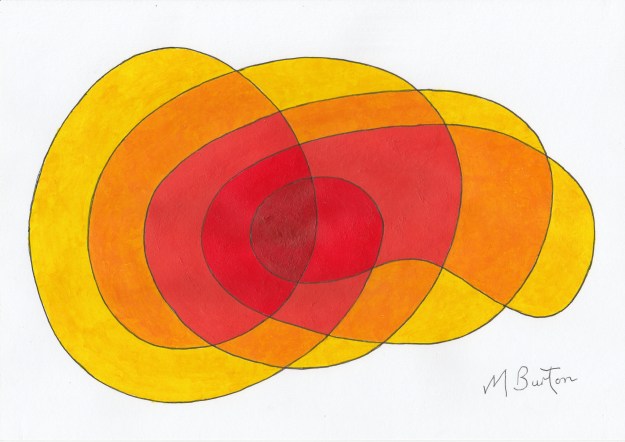
Stage 6. The last colour in the sequence (dark red) is added in the centre. Mick Burton explains colour sequence.
As you will have realised, each loop going over earlier parts of the drawing adds a level, like overlapping shadows or leaves on a tree looking darker as they overlap. The direction of darker tones of colour in the sequence reflects this.
In more complex drawings, however, the sequences of colours can change direction. To show this we need to have a different single continuous line.
Start drawing your line with two loops from the lower left in an anticlockwise direction as before. When you reach the upper left change to doing three loops in a clockwise direction and then go back to the start by a line running underneath.

Stage 7. Start drawing your line from the lower left in an anticlockwise direction doing loops and when you reach the higher left change to clockwise loops running back to the right. Then finish clockwise running underneath to the start. Mick Burton explains colour sequence.
Here is confirmation of the directions of the line, anticlockwise and clockwise, and how they change and run back over earlier lines. We now have a more complex drawing for colouring.
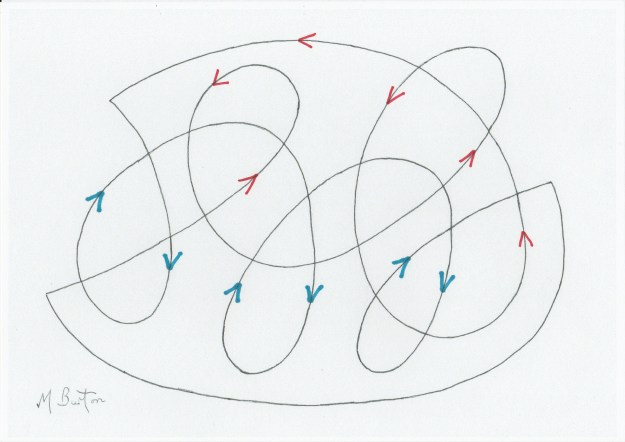
Stage 8. Here is the completed single line with the directions shown – red for anticlockwise and blue for clockwise. Mick Burton explains colour sequence.
By applying alternate overdraw in red we split the drawing into corridors which look a bit more complicated than the simple anticlockwise drawing we did earlier.
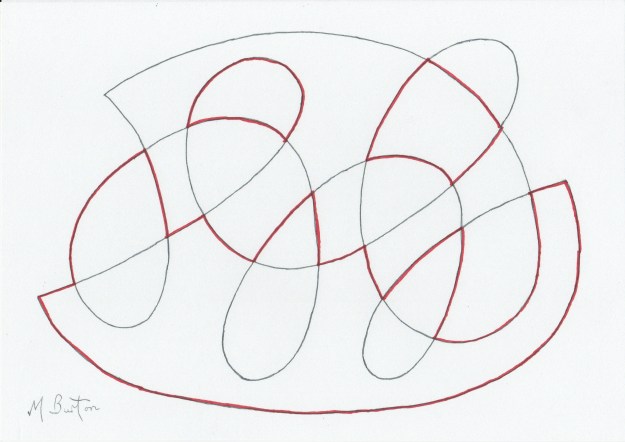
Stage 9. Alternate overdraw in red splits the new drawing up into corridors for colouring. Mick Burton explains colour sequence.
When we number the areas, starting at 0 on the outside as before, we have plus numbers at the top of the drawing but minus numbers appear in the lower corridor. When we follow the natural sequence of numbers downwards from 2 through 1 and 0 we hit -1 and -2.

Stage 10. Numbering from 0 on the outside as before we get minus numbers as well as plus. Mick Burton explains colour sequence.
After I had been doing my colour sequence for a few years I found out that mathematicians call this mix of anti and clock directions Winding Number Theory. When you continue with loops in an anticlockwise direction you are adding levels of overlap and when you change to clockwise you start reducing levels.
We can now apply alternate colours yellow and red to the upper channel.

Stage 11. First set of alternate colours in the upper channel on the complex drawing. Mick Burton explains colour sequence.
Then we can complete the positive colour direction.

Stage 12. Completing the plus direction colours by adding dark red. Mick Burton, continuous line artist.
Now looking at the lower colours, in the clockwise section of the drawing we add the final two colours alternately.
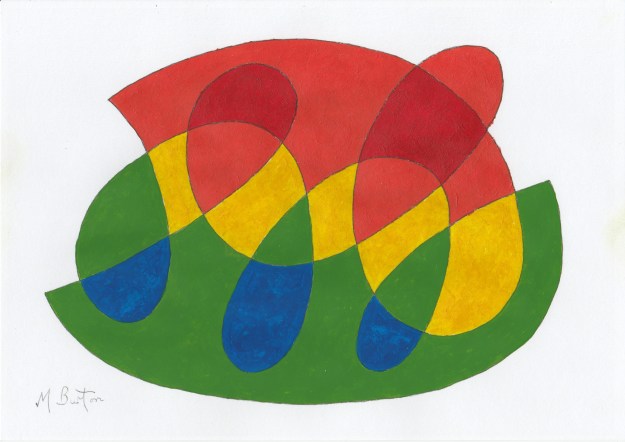
Stage 13. Complete colour sequence on single continuous line drawn in both anticlockwise and clockwise directions. Mick Burton, Leeds artist.
So that is the basis of how I do my colour sequence.
For my elephant, it is more complicated and I show below my sketch after doing the alternate overdraws to create the corridors of alternate colours and then numbered the colours throughout.

Single continuous line elephant showing alternate overdrawn lines in red and colour numbering. The key to the colour sequence and numbering is shown. Mick Burton, continuous line artist.
I have shown the key to the colour sequence and numbering in the top right corner. The colours can be employed in the opposite direction, of course, but with all my drawings the choice of which direction of sequence to adopt is not too difficult. The darker colours fall lower down or on the main body of the animal and the more delicate red, orange and yellow mostly on the face.
I only use red once, and that is on the eye. This really reflects the greater detail on a face which extends the colour range. Several of my colour sequence animals have the eye coloured by an end of range colour only used once in the drawing, eg. Iguana, Harriet the Hen and Olympic Lion.
The completed elephant, at the top of the post, has a story behind it. I did the initial drawing in my demonstration to Harrogate and Nidderdale Art Club on 6 December 2018, which is the day my first grandson, Lucas, was born in Glasgow, son of Kate and Mark.
I have decided to call the elephant Clyde after the famous Glasgow river. Lucas can have a picture on his wall which is exactly as old as he is.













































